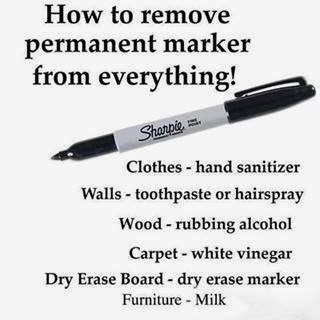Conquer Sharpie Stains: Your Ultimate Removal Guide
Oh no, a rogue Sharpie has marked its territory on your favorite shirt, your pristine wall, or maybe even your new car! That sinking feeling of panic is all too familiar. But don't despair, because conquering these permanent marker mishaps is entirely possible. This guide will empower you with the knowledge and techniques to effectively erase Sharpie marks from a variety of surfaces, restoring your items to their former glory.
Sharpie stains are a common household problem, often striking when you least expect them. Whether it's a child's artistic endeavors gone awry or an accidental slip of the pen, knowing how to address these marks can save you from frustration and potentially costly replacements. From clothing and furniture to walls and even skin, unwanted Sharpie marks can appear anywhere. But armed with the right tools and methods, you can tackle these stains head-on.
The history of Sharpie markers dates back to 1964 when Sanford Ink Company introduced the first permanent marker. Initially marketed for industrial use, Sharpies quickly gained popularity for their bold, long-lasting ink. This very quality that makes them so useful also makes their accidental marks a significant cleaning challenge. The main issue with removing Sharpie is its permanence. The ink is designed to adhere strongly to surfaces, making it resistant to typical cleaning methods.
Understanding the composition of Sharpie ink is crucial for effective removal. The ink is primarily xylene-based, a solvent that dries quickly and bonds tightly to various materials. This explains why water alone is often ineffective in removing Sharpie marks. Instead, we need to employ methods that can break down or dissolve the ink, allowing it to be lifted from the surface.
One simple example is using rubbing alcohol (isopropyl alcohol) on a hard, non-porous surface like a countertop. The alcohol acts as a solvent, breaking down the Sharpie ink. Applying a small amount to a cotton swab and gently rubbing the stain will often lift the mark. This illustrates the principle of using a substance that can dissolve the ink without damaging the underlying material. Now, let's delve deeper into the various methods for removing Sharpie from different surfaces.
Successfully eliminating a Sharpie stain can bring a sense of accomplishment and relief. Knowing how to tackle these marks can save you money by avoiding the need to replace stained items. Furthermore, it empowers you to maintain a clean and organized environment, free from unsightly ink blemishes.
Action Plan: Test any cleaning solution on an inconspicuous area first to ensure it doesn't damage the surface. Work in a well-ventilated area when using solvents like rubbing alcohol or nail polish remover. Blot, don't rub, to avoid spreading the stain. Patience is key, especially with stubborn marks.
Advantages and Disadvantages of Different Removal Methods
| Method | Advantages | Disadvantages |
|---|---|---|
| Rubbing Alcohol | Effective on hard surfaces, readily available | Can damage some plastics and painted surfaces |
| Nail Polish Remover | Powerful solvent, good for stubborn stains | Can damage delicate fabrics and some plastics |
Best Practices: 1. Act fast: Fresh stains are easier to remove. 2. Test in an inconspicuous area. 3. Work in a well-ventilated area. 4. Blot, don't rub. 5. Be patient.
Real Examples: 1. Removing Sharpie from a white shirt using rubbing alcohol. 2. Cleaning Sharpie off a wooden table with hairspray. 3. Erasing Sharpie from a wall using a magic eraser. 4. Removing Sharpie from skin using hand sanitizer. 5. Removing Sharpie from leather using a specialized leather cleaner.
Challenges and Solutions: 1. Stubborn stain: Try a stronger solvent like nail polish remover. 2. Stain on delicate fabric: Seek professional cleaning. 3. Stain on porous surface: Try a specialized cleaner or consider repainting. 4. Stain spread while cleaning: Blot carefully and avoid rubbing. 5. Damaged surface after cleaning: Test cleaning solutions in an inconspicuous area first.
FAQs: 1. Can you remove Sharpie from clothes? Yes, methods like rubbing alcohol, hairspray, or even hand sanitizer can be effective. 2. How do you get Sharpie off walls? Magic erasers, baking soda paste, or rubbing alcohol can work. 3. Will Sharpie come off skin? Usually, soap and water, hand sanitizer, or rubbing alcohol will do the trick. 4. What removes Sharpie from plastic? Rubbing alcohol, nail polish remover, or even sunscreen can be effective. 5. How to get Sharpie off wood? Try rubbing alcohol or a magic eraser. 6. Can you remove Sharpie from leather? Use a specialized leather cleaner. 7. What is the best way to get Sharpie off glass? Rubbing alcohol or a glass cleaner should work. 8. How can I remove Sharpie from metal? Try rubbing alcohol or WD-40.
Tips and Tricks: For stubborn stains, try a combination of methods. Consider using a toothbrush or cotton swab for precise application. Always work in a well-ventilated area when using solvents.
Knowing how to effectively remove Sharpie marks is a valuable skill for anyone. From accidental spills to children's artistic expressions, Sharpie stains are a common occurrence. By understanding the nature of Sharpie ink and employing the right techniques, you can conquer these stains and save your belongings. Remember the importance of testing cleaning solutions in an inconspicuous area first to avoid damaging surfaces. The benefits of knowing how to tackle these stains are clear: you save money, maintain a clean environment, and avoid the frustration of permanent marks. Take action now and equip yourself with the knowledge to combat Sharpie stains effectively. This guide provides you with a comprehensive toolkit to address any Sharpie mishap, empowering you to maintain a clean and stain-free environment. So, the next time you encounter a rogue Sharpie mark, don't panic—you've got this!
Farrow and ball pale blue paint disrupted interior design
Unveiling the drama married at first sight chapter 2850
Decoding your wheels a guide to measuring tire lug patterns








:max_bytes(150000):strip_icc()/How-to-remove-permanent-marker-from-wood-5079775_final-8521eebf125c408094406c2287f62a73.png)





